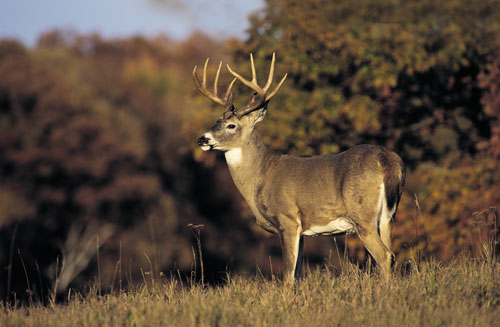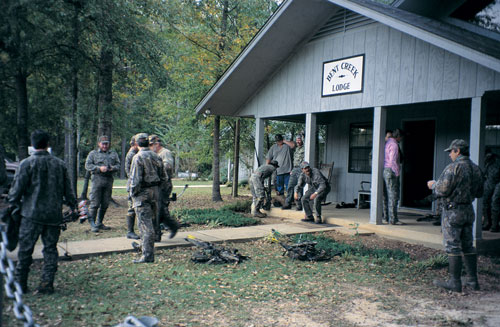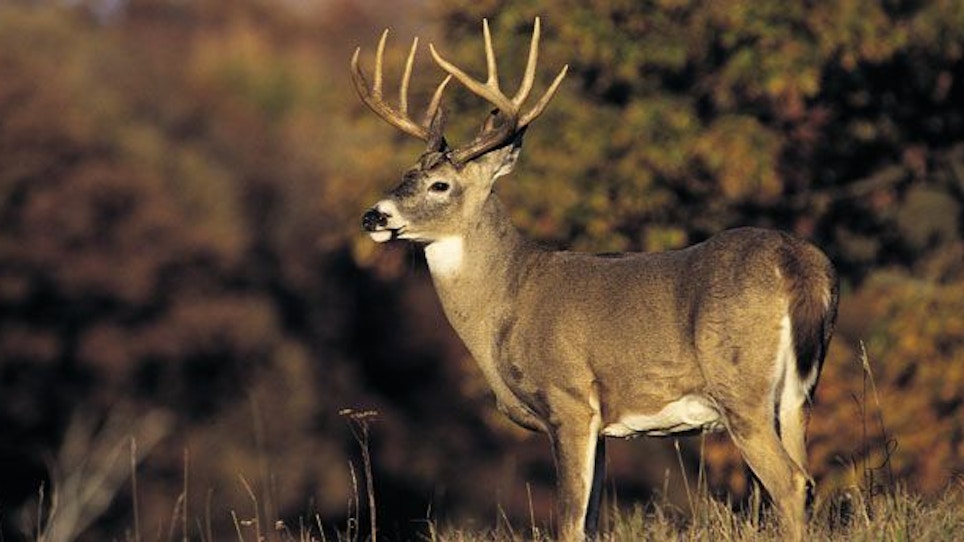 It was about 5 p.m. when Earl Bentz first spotted a doe feeding in the Trigg County, KY, field. She kept looking behind her while moving to a spot downwind of the bowhunter. Finally, she spooked and ran.
It was about 5 p.m. when Earl Bentz first spotted a doe feeding in the Trigg County, KY, field. She kept looking behind her while moving to a spot downwind of the bowhunter. Finally, she spooked and ran.
At first Bentz believed the doe had ruined his hunt, but he suddenly saw an enormous buck step out of a ditch just beyond a cedar tree he’d pinpointed earlier using his rangefinder.
The buck was just beyond the cedar tree, so Bentz knew the distance was 42 yards—a long shot by southern whitetail standards. But Bentz had been shooting long distances for elk that year, and his fine-tuned, long-range practicing made him confident. The buck was walking, and Bentz whistled to stop him, but the buck had eyes for the doe and continued a steady gait. Leading the buck’s front shoulder about 12 inches, Bentz drew his 70-pound PSE bow, and loosed an Easton shaft fitted with a two-blade broadhead. Just before the arrow reached the buck, it appeared to turn, and for a moment Bentz thought he’d missed.
To be sure not to jump a wounded buck, Earl waited 45 minutes to begin trailing, then quickly found the deer 150 yards away in woods just out of the alfalfa field.
Earl Bentz bowhunts in Trigg County, Kentucky because of its reputation for producing enormous-racked whitetails. In three days hunting Bentz saw plenty of deer, including a lot of nice bucks, but none of true monster status until late on the third day.
In 33 years of bowhunting whitetails across America, that Kentucky buck proved the best for Bentz, with gun or bow. It weighed 190 pounds field dressed, had 13 measurable points with an 18 1⁄2-inch inside spread. The 4 1⁄2-year-old buck’s rack is tall, with lots of mass, and gross-scored 176 P&Y.
That same autumn, Bentz’s close friend and game call manufacturer Harold Knight was bowhunting in Tennessee. Knight had located a good-looking area in Stewart County that mid-October. Bucks were just coming into rut, making scrapes and rubs.
It was late afternoon when Knight placed his stand along an old logging road that connected two clover field feeding areas. Almost immediately he began seeing deer. The logging road was thick with tangled cover, and deer walking it could not be seen at a distance. So when Knight saw a good buck coming, he had only seconds to get ready and take the shot.
Knight quickly came to full draw, as the buck stopped at 18 yards when the bowman whistled softly to it. The deer turned and looked up at the hunter, but it was too late. The 90-grain, three-blade-tipped shaft struck the buck through the shoulder, piercing its heart, and exited the opposite side of the deer. The 3 1⁄2-year old, 153-inch gross-scoring buck raced just 70 yards before falling.
 Saga Of The South
Saga Of The South
Such tales of giant bucks falling to bowmen are not rare. Instead, these types of stories are increasingly common throughout the South—where the deer seasons are long, the limits liberal, the abundance of game remarkable, and the quantity of record book bucks growing every year.
From West Virginia to Mississippi, Tennessee to Florida, huge numbers of whitetails are being harvested by countless Southern bowmen. And many of these deer are huge, something unknown by many hunters living outside the region. I have spoken with northern hunters who think all southern whitetails are diminutive animals—something on the order of the tiny Key deer, which are unique to the Florida Keys. But 200-pound whitetail bucks are regularly collected throughout much of the South.
And when it comes to book bucks, Dixie doesn’t take a backseat to any region. In truth, the recordbook buck tales at the beginning of this story are but a small sampling of the kind of quality whitetails available today in the South, thanks to sound game management practices and hard work by knowledgeable hunters and wildlife biologists.
Next: Rambling Rut, Sweat And Kitty Litter






